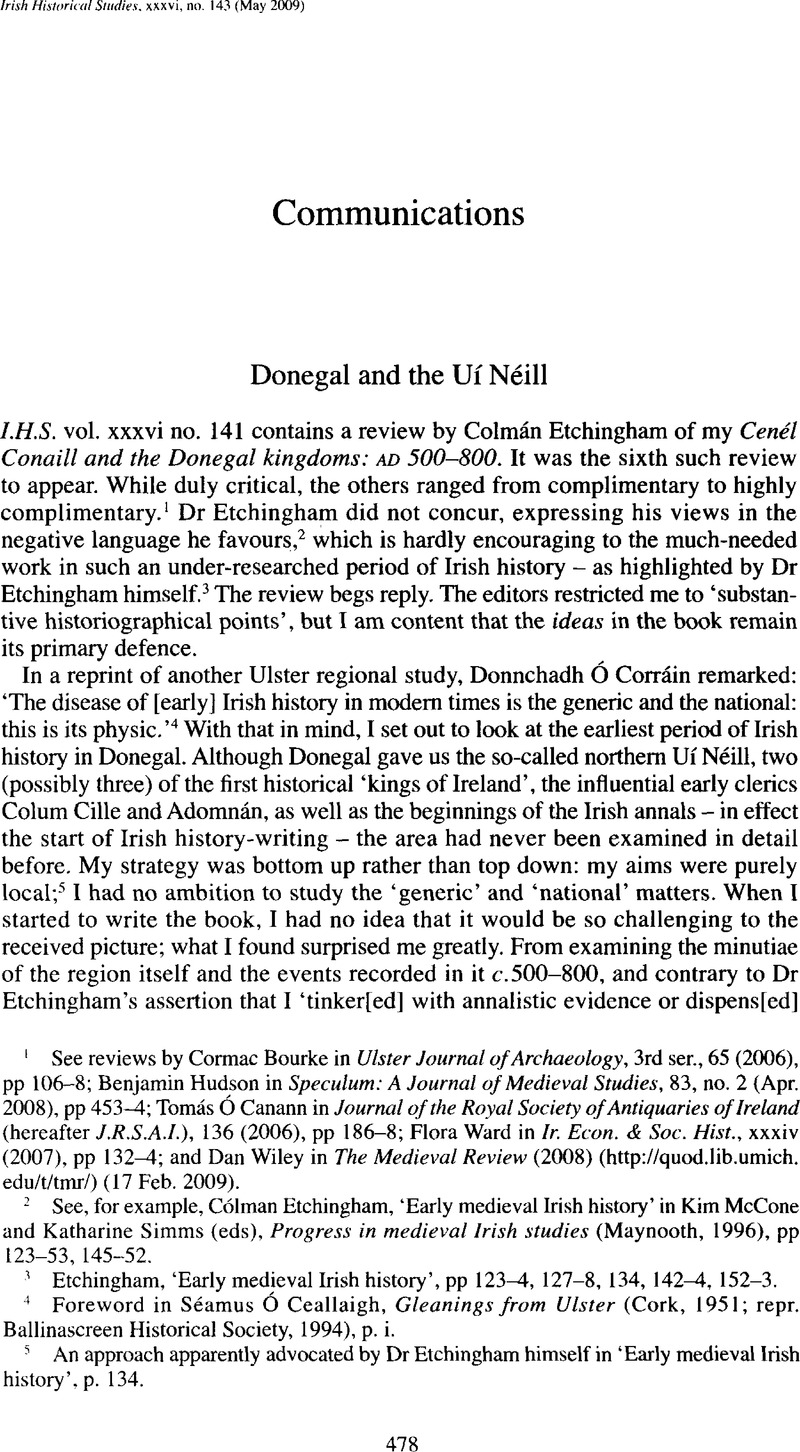No CrossRef data available.
Article contents
Abstract

- Type
- Communications
- Information
- Copyright
- Copyright © Irish Historical Studies Publications Ltd 2009
References
1 See reviews by Bourke, Cormac in Ulster Journal of Archaeology, 3rd ser., 65 (2006), pp 106-8Google Scholar; Hudson, Benjamin in Speculum: A Journal of Medieval Studies, 83, no. 2 (Apr. 2008), pp 453-4CrossRefGoogle Scholar; Canann, Tomás Ó in Journal of the Royal Society of Antiquaries of Ireland (hereafter J.R.S.A.I.), 136 (2006), pp 186-8Google Scholar; Ward, Flora in Ir. Eton. & Soc. Hist., xxxiv (2007), pp 132-4Google Scholar; and Dan Wiley in The Medieval Review (2008) (http://quod.lib.umich. edu/t/tmr/) (17 Feb. 2009).
2 See, for example, Etchingham, Cólman, ‘Early medieval Irish history’ in McCone, Kim and Simms, Katharine (eds), Progress in medieval Irish studies (Maynooth, 1996), pp 123-53, 145–52.Google Scholar
3 Etchingham, ‘Early medieval Irish history’, pp 123–4, 127–8, 134, 142–4, 152–3.
4 Foreword in Ceallaigh, Séamus Ó, Gleanings from Ulster (Cork, 1951; repr. Ballinascreen Historical Society, 1994), p. i.Google Scholar
5 An approach apparently advocated by Dr Etchingham himself in ‘Early medieval Irish history’, p. 134.
6 Shamhráin, Ailbhe Mac, ‘Nebulae discutiuntur? The emergence of Clann Cholmáin, sixth-eighth centuries’ in Smyth, A. P. (ed.), Seanchas: studies in early and medieval Irish archaeology, history and literature in honour of Francis J. Byrne (Dublin, 2000), pp 83–97Google Scholar; see also Edel Bhreathnach, ‘The political context of Baile Chuinn Chétchathaig’ in idem (ed.), The kingship and landscape of Tara (Dublin, 2005), pp 49–68.
7 Lacey, Brian, Cenél Conaill and the Donegal kingdoms AD 500–800 (Dublin, 2006), pp 178-85Google Scholar; idem, ‘The battle of Cúl Dreimne - a reassessment’ in J.R.S.A.I., 133 (2003), pp 78–85.
8 Byrne, F. J., Irish kings and high-kings (London, 1973), p. 96Google Scholar; Thomas|Charles-Edwards, Early Christian Ireland (Cambridge, 2000), p. 295Google Scholar; Enright, M. J., ‘Royal succession and abbatial prerogative in Adomnán’s Vita Columbae’ in Peritia, 4 (1985), pp 83–103.CrossRefGoogle Scholar
9 For a summary of views on the origins and propagandistic basis of the annals, see Evans, Nicholas, ‘Annals and chronicles’ in Duffy, (ed.), Encyclopedia, pp 20-3 and references thereinGoogle Scholar; see also Thomas Charles-Edwards, The Chronicle of Ireland (Liverpool, 2006), pp 7–16Google Scholar, and most importantly McCarthy, D. P., The Irish annals (Dublin, 2008), esp. ch. 5–6.Google Scholar
10 For a summary of views on the ‘non-oral origins’ and propagandistic ‘forging’ of the genealogies, see Nollaig Ó Muraíle, ‘Genealogy’ in Duffy (ed.), Encyclopedia, pp 194–5 and references therein; for a separate opinion on the eighth-century drawing up of the ‘familiar Ui Neill genealogical framework’, see Mac Shamhrain, ‘Nebulae discutiuntur?’, p. 97; for another ‘invented’ genealogical scheme associated with Áed Allán, see Charles-Edwards, Thomas, ‘The Uí Néill 695-743: the rise and fall of dynasties’ in Peritia, 16 (2002), pp 396-418CrossRefGoogle Scholar.
11 See note 1 above.


